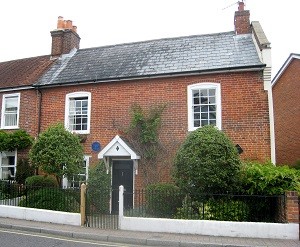The young Ned Lawrence first came to this area as a five-year-old when the family moved here from Brittany in 1894.
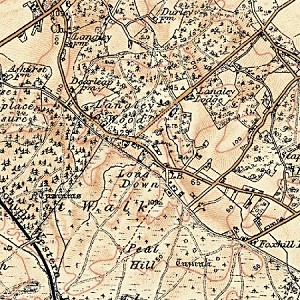 They spent three summers living at Langley Lodge, on the edge of the New Forest. Its
They spent three summers living at Langley Lodge, on the edge of the New Forest. Its
isolated position can be appreciated from
this extract from the 1897-1909 Ordnance Survey Revised New Series map. The house has since been demolished.
It was probably while living here that Lawrence went sailing with his father on Southampton Water, though years later he confessed to a Royal Navy lieutenant, ‘I will never be a sailor, I’m afraid: born too late, though my father had yachts and used to
take me with him from my fourth year: but my attempted accomplishment is motor-boating, a very different art, and as difficult.’
Indeed, more than thirty years after Lawrence first lived here, it was his RAF career – and his interest in the development of rescue boats, in particular – that would bring him back to the area, first as a clerk helping to organise the 1929 Schneider Trophy race for seaplanes and flying boats, and again in the 1930s while working on high-speed launches for the RAF.
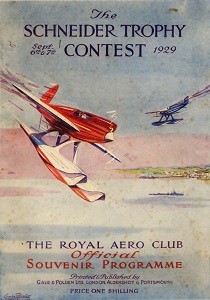 Calshot
Calshot
Shortly after his return from India at the beginning of 1929, Lawrence assisted his new Commanding Officer, Wing Commander Sydney Smith, in organising the prestigious Schneider Trophy race that took place in September off Calshot, at the southern end of Southampton Water.
The Schneider Trophy race was staged eleven times
between 1913 and 1931. Calshot hosted the race for the first time in 1929 and again in 1931.
Lawrence spent much of the duration of the 1929 event living aboard a yacht, Karen, and as a reward for his help with the event, he was given a model of the winning Supermarine S6 seaplane which can be seen at Clouds Hill.
It was here also that Lawrence and Sydney Smith were presented with one of the yacht’s tenders after Lawrence gave it an overhaul – a Biscayne Baby speedboat which they renamed Biscuit and took back to Plymouth.
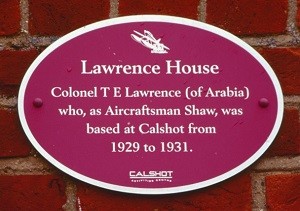 Today, Lawrence’s association with Calshot is marked by a red plaque on the wall of Lawrence House, one of the red-brick buildings that now forms part of the Calshot Activities Centre located on
Today, Lawrence’s association with Calshot is marked by a red plaque on the wall of Lawrence House, one of the red-brick buildings that now forms part of the Calshot Activities Centre located on
Calshot Spit.
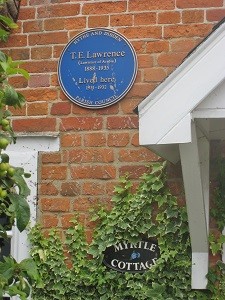 Hythe and Southampton
Hythe and Southampton
Driving the Biscuit around Plymouth Sound and up the Tamar estuary gave Lawrence much experience of
powered craft. However, it was seeing the fatal crash
of a Blackburn Iris III flying boat in Plymouth Sound in February 1931 that prompted him to devote much of the remainder of his service years assisting in the development of high-speed rescue craft for the RAF.
In 1931-1932, he was posted at Hythe where Hubert Scott-Paine had begun building hard-chine planing hulls at the British Power Boat Co. Here, Lawrence oversaw the construction and trials of power boats for the RAF.
During most of this time, Lawrence lodged at Myrtle Cottage in Shore Road, Hythe, where a blue plaque records his occupation.
‘Do you ever get near Hythe in your wanderings? I base here, and test or tune motor boats for a living – 3/9d a day – but interesting, and I get what I want done.’
T. E. Lawrence to Colonel S. F. Newcombe, 1932
Further along Shore Road can be found many modern hangars and the ruins of older buildings which mark the site where the British Power Boat Co. was located. Some of the concrete slipways that may have been used to launch the power boats can be seen along the shore.
Lawrence’s work on the development of power boats was to take him to many locations over the remainder of his service career. 1933 saw him based briefly across the Solent at White’s shipyard in East Cowes, where he lodged at 119 Clarence Road. In July 1933, he took lodgings at 13 Birmingham Street, Southampton, and this became his base for much of the next 18 months. The house no longer stands.
Frequently, though, Lawrence travelled to other parts of England; sometimes by power boat, sometimes by train, but usually on his Brough Superior. One wonders what mileage rate the RAF paid for the use of his own motorcycle?
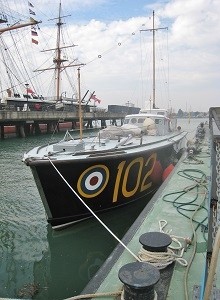 Anyone interested in Lawrence’s involvement with the development of power boats should certainly consider a visit to Portsmouth Historic Dockyard where HSL 102 is berthed. HSL 102, built by Hubert Scott-Paine’s British Power Boat Co. in 1936, is the only survivor of the
Anyone interested in Lawrence’s involvement with the development of power boats should certainly consider a visit to Portsmouth Historic Dockyard where HSL 102 is berthed. HSL 102, built by Hubert Scott-Paine’s British Power Boat Co. in 1936, is the only survivor of the
100 class of high-speed launches built in the UK, and was one of the first fast offshore rescue boats in service with the RAF.
Even though this particular class was not worked on by Lawrence, the boat contained many design features and developments made possible by the 200 class which he worked on.
In 2013 members of the Society enjoyed a rare opportunity to take HSL 102 out into the Solent, where we were able to put her through her paces in a thrilling ride across to the Isle of Wight and back.
Everyone got the chance to take the wheel and drive at speed
– a thrilling experience on such an historic boat.
What’s it like to drive this historic high-speed craft?
Put yourself at the wheel by clicking the link below
……………………………………………………………………………
Photos © Charles Eilers (Lawrence House); Alison Jolley (Myrtle Cottage and HSL 102)
